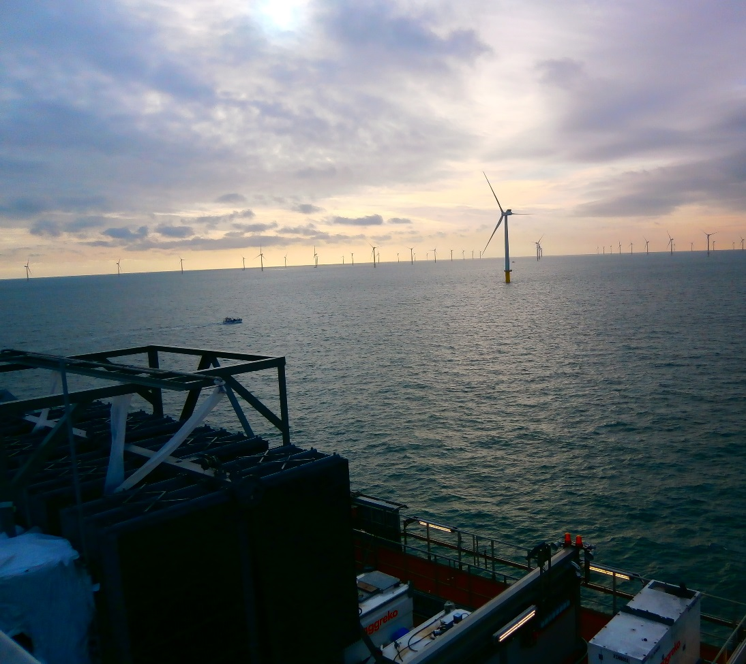Today we celebrate diversity and all women in engineering roles around the world. Diversity and inclusion are essential to our culture and have an immediate impact on all aspects of our business. Just as we value the different strengths of our people, we seek to promote this same recognition for all industry professionals who, with their varied experiences and perspectives, contribute to find the best solutions for our global society.
Today is the International Women in Engineering Day (INWED) and in this, its seventh year, individuals and organisations from all over the world come together to raise awareness on how female engineers should tie in with the challenges of an uncertain future.
But, why women in engineering? Traditionally, there have always been sectors and industries comprised of individuals with very similar characteristics. Although there is more than one reason for this, many patterns have remained while global society evolves by leaps and bounds. In the engineering sector, one of the most striking patterns has always been low female participation.
Many industries are recognising the need to diversify workplaces as a matter of fairness. This is a very strong argument and it means goes further. In a multidimensional and complex society like the current one, focusing on maximising of a diverse workforce –meaning varied and heterogeneous in terms of origin, gender, ages or abilities– has almost become a business imperative. Diversity brings better financial results to organisations; they are more creative and more effective in fostering strong business relationships. Why? Because the greater the diversification in experiences and perspectives, the greater the enrichment in the working teams. Good business solutions can come from many work environments, but the best solutions come from wider points of view. However, there is a part of the equation that is often missed: promoting an inclusive culture in the workplace.
Inclusivity implies an environment in which respect, fairness and positive recognition of differences are cultivated. Therefore, organisations must boost values such as representation, responsiveness and equal opportunities for everyone. After all, the most important thing is what people can contribute to the work environment and not what sets them apart from the rest.
About INWED
Initially known only as Women in Engineering Day (WED), this awareness campaign was launched for the first time in the UK in 2014 by the Women’s Engineering Society (WES), with the main objective of raising the profile of women in the engineering sector. Thus, in addition to rendering a minoritarian group visible in the sector, it would improve young women’s knowledge, perceptions and desirability of engineering. Since then, WED has been acquiring more and more recognition in the following years. In 2016, UNESCO offered its patronage and, a year later, WED became INWED: an international event held in the interest and enthusiasm of a growing worldwide audience. In each new edition, the campaign seeks to achieve a greater global reach, already having participants from Canada, Ecuador, Australia, Rwanda, Hong Kong, among many other countries.
INWED encourages all governmental, educational, institutional and corporate engineering organisations to coordinate and execute their own activities to raise awareness and link them together for maximum impact through its website and supporting resources. Fostering great opportunities for women in engineering is essential to make the sector entirely inclusive, which beyond the fairness and creation of new opportunities for differentiation and growth, is also increasingly tied to improve the work-force (Sobhani & de Jongh, 2017). Everyone can help to raise the profile of women engineers and encourage more people to consider engineering as a profession for all.
In 2020, the event is focused on enhancing the opportunities and recognising achievements of women engineers, within the framework of the ‘Shape the World’ theme. What does it mean? The topic refers to how engineers advocate ‘shaping’ solutions to current issues that threaten our quality of life. Problems stemming from climate change or the rapid population growth, for example, are some of the challenges that they must tackle. INWED aims to receive and share the stories of those solutions and the minds behind them, who contribute to make our planet a better, safer, more innovative and exciting place to be. (Find out more here).
A call for action
Increasingly, governments and the private sector are trying to bridge the engineering employment gap. This problem is being tackled in some cases from elementary school, where more and more children are encouraged, regardless of their environment or gender, to increase their interest in science, math and technology; which will eventually lead them to consider a career in these fields.
An OEDC report (2017) revealed that, on average, only 5.3% of 15-year-old girls from their member countries in contrast to 12.2% of their male peers, have expectations of a career as an engineer. This implies that the latter are about 2.4 times more likely than girls to eventually belong to the engineering sector, the US being the country in which this probability is higher, since boys are 3.3 more likely than girls of having these expectations. In fact, recent statistical data (2019) on people employed in that country shows that of the total number of people with occupations related to architecture or engineering, only 15.7% are women. However, this reality does not differ so much from that of other countries. In the UK (2019), for example, only 12% of workers in engineering occupations were women, more women having an engineering role outside the engineering sector than within.
According to some surveyed women, succeeding in engineering can be a challenge for them because it tends to be a sector traditionally dominated by men, and that does not evolve at a rate equal to society. Although low gender representation is only one part of the problem, the magnitude of this imbalance in the sector requires immediate action. Henceforth, institutions and companies need to further diversify their work environments. This goes beyond new revenue and growth, but to improve competencies as organisations and, more importantly, to respond to a societal call for greater transparency and responsibility, in order to build a more sustainable, equitable and inclusive future.
The richness of our diversity
At Linxon, our doors are open to talent, regardless of gender, origin or environment. Our large family includes people of 40 different nationalities, of whom 10% on average are women. Although our female colleagues are the minority in sites and sales activities, they represent more than 30% of the executive management team, having an immediate contribution and a subsequent impact on all aspects of our business. Likewise, there is a good balance in the leadership team, especially with regard to gender, culture and national representativeness.
“The benefits of diversity are not only bigger innovation, an improved decision making process, a higher job acceptance rates or a better performance than competitors, they are also a nicer climate at work, a permanent exchange of ideas creating the ground for personal growth”, states Frédéric Tréfois, CEO of Linxon.
We are fully aware of our areas for improvement; therefore, we recognise the importance of our diversity in all labour aspects. Our global workforce contributes to reach broader segments, booster productivity and develop innovative solutions. This is reflected in our work dynamics and high-standard solutions. We seek to promote an increasingly diverse and inclusive environment, that anticipate social demands and labour reality in our industry. To achieve this, we have internal policies and training modules aimed at reinforcing this inclusive culture at all levels. This is an ongoing process, which we will have to constantly review and re-adapt, but in which we are firmly committed to succeed.
Experiences from our teams

“Being a female in a male-dominated sector is challenging, but I have been fortunate in my early career to work with, be mentored and supported by cultured, well-informed engineers and managers. I don’t feel my gender hindered me when looking for a job in energy sector. Nonetheless, I have spent a large part of my career working either in or interfacing with people from conservative cultures having certain stereotypes, where a woman’s role is more restricted and defined within boundaries. This has, of course, meant that there is more effort required to establish yourself and your authority in order to try and attain equal treatment.
I really enjoy the challenges that I’ve faced so far in my career and fighting stereotypes and unconscious bias motivated me to be my own person. Furthermore, I tried to be role model for young women in education or early careers giving hope of career progression and recognition. My motto is ‘be yourself, anything is possible, never ever give up, many opportunities are out there – do what you enjoy and grasp these great chances that are available.’
Despite an improvement in recent years, there remains still considerable shortage of women pursuing careers in engineering. This is not helping us to realise the full potential of an industry with a diverse workforce. Female engineers bring different perspective, better communication, empathy and intuition to leadership. Diversity enhances creativity and brings a variety of perspectives leading to better decision making and problem solving. This is why International Women in Engineering Day is important, to celebrate the contribution that women bring to the industry.
It is important to emphasize that gender diversity is only one aspect of diversity and we must create an inclusive environment where everyone can be valued for what experiences and insights they can contribute.
In addition to the above, I want to share my experience in Linxon on diversity, which is so positive and promising. When I look at our management team, one third of them are women. We all see inclusivity and equality in the workplace and Linxon management, putting so much efforts to raise the profile of women in engineering and promoting inclusiveness and diversity in our company culture.
I wish women will be more involved in engineering sciences in the future and this diversity brings a complementary development to the industry. Happy Women in Engineering Day.”
—Selma Palaz, Chief Sales Officer, Turkey.
 “Graduating and working in a middle eastern country and then moving to the UK as a skilled worker have given me the chance to experience different cultures in workplaces as well as working with diverse teams. Obviously, this has been challenging at times, especially in many meetings where I have been the only female in the room. It has not always been easy. However, I have been also fortunate to meet and work with very experienced and decent male and female colleagues, to make the whole experience easier and more pleasant.
“Graduating and working in a middle eastern country and then moving to the UK as a skilled worker have given me the chance to experience different cultures in workplaces as well as working with diverse teams. Obviously, this has been challenging at times, especially in many meetings where I have been the only female in the room. It has not always been easy. However, I have been also fortunate to meet and work with very experienced and decent male and female colleagues, to make the whole experience easier and more pleasant.
The necessity of diversity is well recognised and currently many companies have policies on this matter. However, in order to have more women in engineering, we need more schoolgirls going into engineering. I was a STEM ambassador in my previous jobs and met with high school students interested in engineering, as part of school support programme. Unfortunately, my experience also showed me that the number of girls interested in engineering was even lower than the current national rates. This is why I believe that we need to make engineering more attractive to students in general and specifically girls. Knowing that as a female engineer you can have a completely rewarding and satisfying working life as in any other career would make a big difference.
At Linxon, I feel that I have support from my colleagues, both in work and personal matters. Knowing that I am working with such a sympathetic and understating group, has a big impact on job satisfaction, and subsequently on my performance. I have been working with managers who mostly evaluate people based on their abilities and not their origin or gender. This does not mean that I have not seen any inequality, but nothing compared to the positive feedback and support received. Another positive point is the presence of women in different roles and levels of management in the company. Having female colleagues makes the workplace more trustworthy and pleasant. I have always felt part of, which is very important to me as an immigrant. Finally, the benefits we have as employees, such as flexible hours for parents, are another sign of inclusiveness. Regarding parental flexible hours, this is a benefit for both female and male employees, which I think is supporting the gender equality in both workplace and home.
Working in an engineering sector has its challenges but also its opportunities. Being different and having different mindsets means also having different solutions approaches, and potentially bring improvement and innovation in conventional solutions. This is an advantage for any fresh eyes, including women and workforces from overseas. Yet many women engineers are still struggling to prove themselves, and I would like to tell all of them not to give up. There is a lot of men and women that support diversity and gender equality in workplaces. I hope that one day, every individual in any part of the world, could have the opportunity to become what they want, and to be evaluated based on their skillsets and abilities for that role only!”
—Negar Kheirollahi, Project Engineering, UK.
 “I think overall that I have been treated well in my career as an engineer, but I have of course also been able to notice that men and women are not treated equally in working life, and the lack of women in most positions. This is not something that has changed for the better during the time I have been working in electrical engineering. So, here are some thoughts of the problems and solutions:
“I think overall that I have been treated well in my career as an engineer, but I have of course also been able to notice that men and women are not treated equally in working life, and the lack of women in most positions. This is not something that has changed for the better during the time I have been working in electrical engineering. So, here are some thoughts of the problems and solutions:
The first challenge is of course to recruit women into engineering, which is difficult when hardly any women decide to study electrical engineering. My daughter, for example, is studying bio engineering in Uppsala at the moment, and there are no women in the electrical engineering course. The second challenge is to create a working environment where women want to stay in engineering. It is a sad fact that many female engineers of all categories drop out of the field, probably because they get tired of being the only one is a group. To make it attractive to women in technology, I think you have to reach a critical mass of women in a work group. Having one or two token women in an otherwise all-male group will not help, they will most likely leave.
The other thing you need to do is to give everyone in team irrespective of age, race and gender the same opportunities. This might sound obvious but is not the case in most places I have worked, and I think the only way to solve this is for the employers to start looking a bit more outside the famous box. The standard is a still a white male with a degree in engineering who graduates at 25-26 and then becomes manager when he is 30. Women do not fit into this mold. Firstly, being the wrong sex, and then, often starting later because of family or having retrained from other professions. I was 36 when I started working as an engineer, and I have often felt that the fact that I was older than my fellow male colleagues has meant fewer opportunities.
What I think value most about diversity in the working environment is to not feel like the odd one out. When you are the only woman in a team, you tend to be seen as a representative for all women. I still feel women have to try much harder and be better than men to succeed. When a woman fails, it is often seen as a failure for all women. It is tiring to constantly be made aware of the fact that you are a woman and therefore somehow inherently different. In a inclusive group, you will be seeing everyone as an individual and forget about factors like gender or race. Then everyone will get the same opportunities based on their own capability.”
—Anna Knapp, Tender Manager, Sweden.
References:
EngineeringUK. (2019). EngineeringUK: Engineering Brand Monitor 2019. EngineeringUK. Retrieved from https://www.engineeringuk.com/media/196487/engineering-brand-monitor-ebm-2019-full-report-for-website-final.pdf
Firth, L. (2020, 04 28). International Women in Engineering Day: How It Aims to ‘Shape the Engineering World’ for Female Engineers. Retrieved from https://www.electronicspoint.com/opinion/international-woman-in-engineering-day-how-it-aims-to-shape-the-engineering-world-for-female-engineers/
Fouad, N. A., Singh, R., Cappaert, K., Chang, W.-h., & Wan, M. (2016). Comparison of women engineers who persist in or depart from engineering. Journal of Vocational Behavior, 92, 73-93. doi:10.1016/j.jvb.2015.11.002
Organisation for Economic Co-operation and Development. (2017). What kind of careers in science do 15-year-old boys and girls expect for themselves? Paris: OECD Publishing. doi:10.1787/76e7442c-en
Sobhani, S., & de Jongh, R. (2017). Business and the Sustainable Development Goals: Why it matters. In B. Jenks, J. Topping, H. Keijzers, Y. Christiansson, V. Tywuschik, & L. Orrenius, Financing the UN Development System: Pathways to Reposition for Agenda 2030 (pp. 76-79). Uppsala, Sweden: Dag Hammarskjöld Foundation. Retrieved from http://www.daghammarskjold.se/wp-content/uploads/2017/09/UNDS-Financing-Report-2017.pdf#page=76
United States Department of Labor. (2019). Labor Force Statistics from the Current Population Survey. Retrieved from U.S. Bureau of Labor Statistics : https://www.bls.gov/cps/cpsaat11.htm
Women’s Engineering Society. (2020, 02 28). Engineers encouraged to ‘Shape the World’ for #INWED20. Retrieved from Women’s Engineering Society: https://www.wes.org.uk/news/engineers-encouraged-shape-world-inwed20





